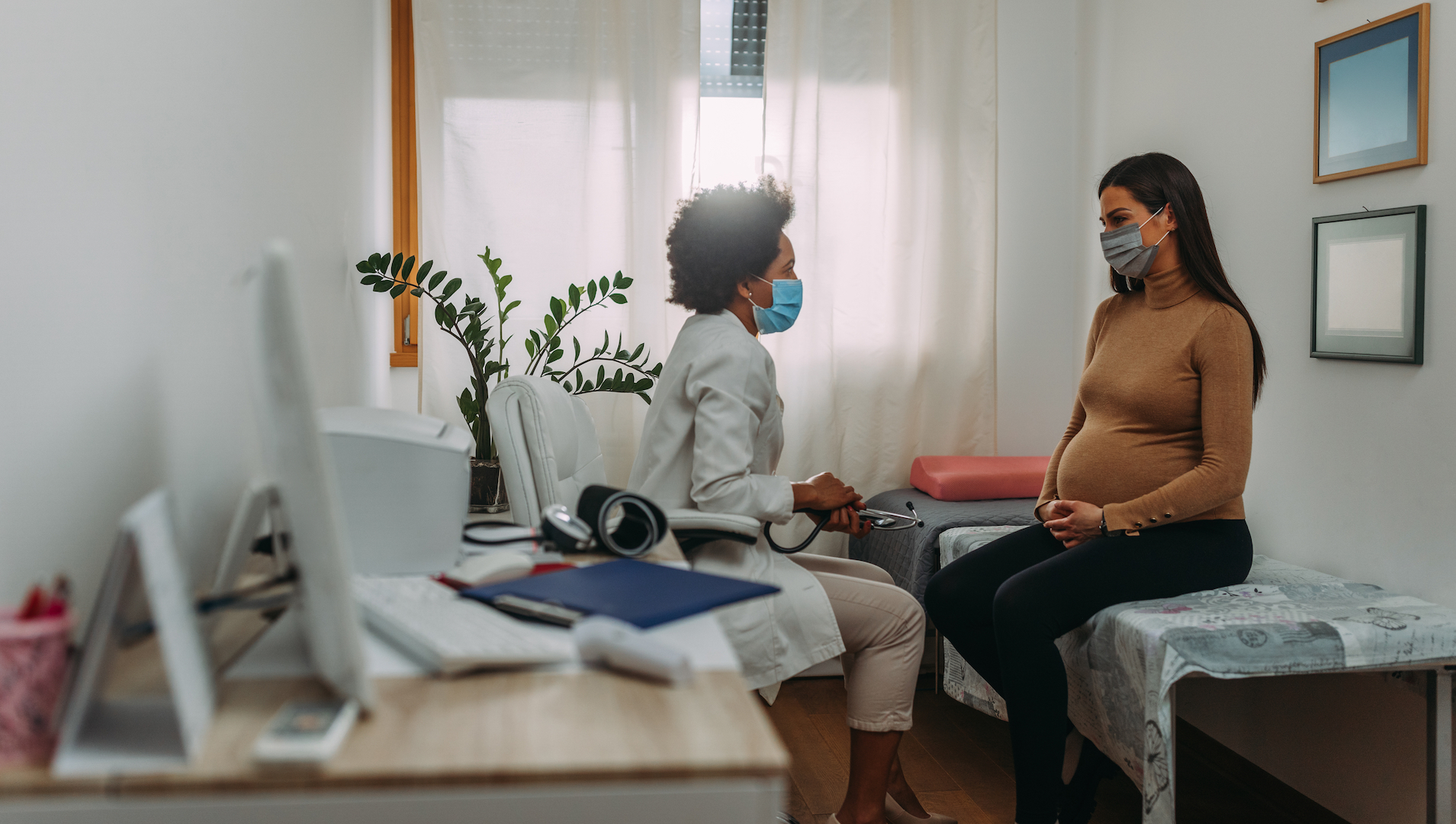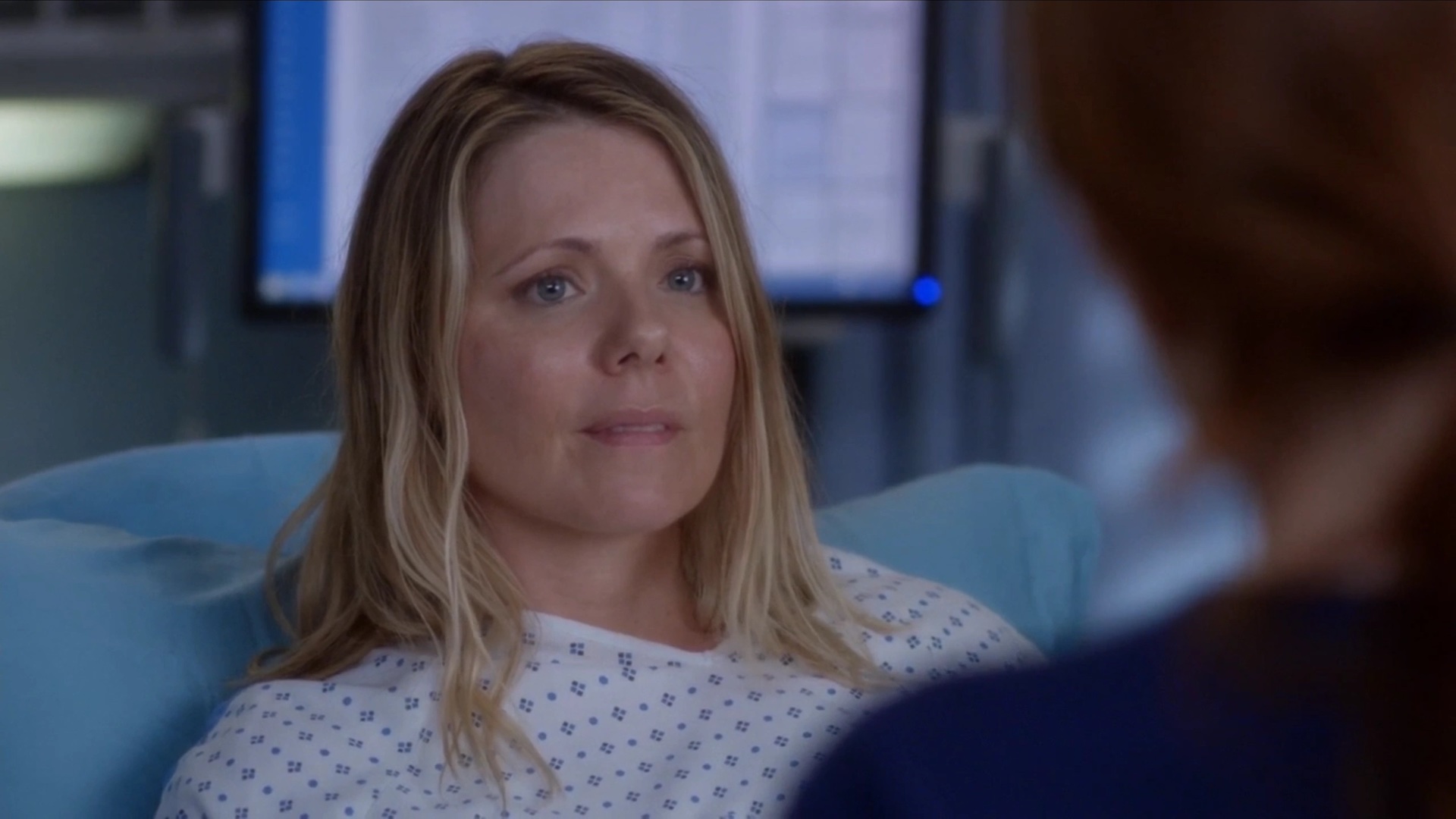As someone who had preeclampsia twice, it’s more than a little embarrassing to admit that Grey’s Anatomy is how I first learned about the condition. In my defense, I started watching the show during my first viable pregnancy (great timing, right?) — hoping it’d be a distraction from the morning sickness and something I could continue into the endless newborn days. By the time I reached Season 14, Episode 10 in my second trimester, I’d already felt my first kicks and, naturally, had gone down the Reddit rabbit hole of what could go wrong during each stage of pregnancy.
I won’t spoil any major plot twists — though we’re talking about a show that’s been around longer than some of us have been alive — but in this particular episode, a pregnant woman arrives at the hospital, her vitals are normal, blood pressure is in the healthy range, and everything seems fine. Then, in true Grey’s fashion, shit hits the fan, and she has to have life-saving surgery that ultimately doesn’t save her life.
Turns out, she had preeclampsia that turned into HELLP syndrome, but it was missed because she had a low baseline blood pressure. This episode was a wake-up call on the importance of knowing your baseline pressure, especially during pregnancy.
Needless to say, I ordered myself a blood pressure cuff on the spot. Was it because of my previous miscarriage? Maybe. Was it because I’m a bit of a hypochondriac? Definitely. Either way, I became hyper-vigilant about taking my pressures, fully expecting that other shoe to drop.
But it didn’t.
My pregnancy sailed by, basically problem-free. My husband joked about my perfect appointment record, proudly telling everyone I was “made for pregnancy.” I kept up my long walks until the day I delivered. My feet didn’t swell until the last week, and my blood pressure remained steady throughout my third trimester, my three-day induction, the delivery with multiple failed epidurals, and the two recovery days in the hospital. It even stayed stable when mom told the entire delivery room that I pooped on the table, that’s how great I was doing.
And then I got home.
The first night with my baby was a reality check. We weren’t prepared for a newborn screaming every two hours, nor were we prepared for the 3 a.m. group project that was parenthood. It was a lot of “Hand me the bottle!” and “You spilled it!” mixed with “I can’t get him to latch!” And of course, my mom, who was sleeping on the couch, would pop in with helpful advice like, “Maybe he’s hungry?”
By the time I woke up the next day (which, honestly, was more like crawling out of the haze), I started to understand why sleep deprivation is considered a form of torture. It wasn’t until I fed the dogs, made sure the baby was comfortable, and used my peri bottle about a thousand times that I remembered to take my blood pressure.
After that Grey’s episode, I’d done my research and discovered that preeclampsia can happen even after you’ve given birth. It was something I’d been told was “extremely rare” (according to some vague websites and the hospital discharge packet), but because I’m a particularly anxious person, I wasn’t taking any chances. Remember the other shoe? Well, it was finally about to drop.
I sat down, strapped the cuff on, and went through the motions that had become routine. The machine beeped, and the red alert light flashed on the monitor, a first for me. I stared at the screen, convinced there had to be a mistake. The reading: 179/110. I tried again. 183/116. And again. And again.
By the time my husband rushed me back to the hospital, leaving our 4-day-old son behind in my mom’s arms, the reading had skyrocketed to 187/123. I was immediately whisked to triage, surrounded by five doctors and nurses. One nurse said I didn’t look like I had preeclampsia, right before my reading sent off the hypertensive crisis alarm. Suddenly, the doctor was worried I’d have a stroke in the elevator if they moved me. My husband’s clammy hand gripped mine. I cried and said, “I don’t want to die.”
Magnesium drip in place, I was stuck in bed, trying to recover, while the nurses kept a close watch on me. Not how I envisioned those first days as a new mom. I stayed in the hospital for four more days, was sent home with blood pressure meds, and now, two and a half years later, I’m still dealing with blood pressure complications from postpartum preeclampsia.
Wait, What Actually Is Postpartum Preeclampsia?

Okay, let’s back up. Maybe it was Grey’s Anatomy (Season 20, Episode 7 also highlights the condition) or the headlines about Meghan Markle’s diagnosis that sent you running to Google, trying to figure out what preeclampsia actually is. I’m glad you’re here, because it’s something that direly needs more attention.
At its core, preeclampsia is high blood pressure plus organ dysfunction — think liver issues and protein in your urine. Dr. Jayme Mitchell, MD, FACOG (who, by the way, is my OB/GYN and *the* best), tells Betches, “Preeclampsia usually means you’re dealing with a blood pressure reading greater than or equal to 140/90 — and we’re seeing it on two different occasions, at least four hours apart. This is why we’re always checking blood pressure during pregnancy.” It’s also why your doctor will take a urine sample and ask you about things like headaches, swelling, and blurry vision at every appointment. And if they’re not? Find a new doctor.
Now, while preeclampsia is typically linked to pregnancy, postpartum preeclampsia is a whole other animal. After you give birth, you could still develop it (some experts say up to six weeks postpartum, others say 12). And that’s the problem — it can be hard to catch.
The symptoms of postpartum preeclampsia can be — and oftentimes are — dismissed as ~normal postpartum stuff.~ Which is why, as Eleni Tsigas, CEO of the Preeclampsia Foundation, says, it’s particularly dangerous. “Many of the symptoms, like swelling, headaches, and anxiety are commonly attributed to ‘just having a baby.’ In reality, your blood pressure could be dangerously high,” she explains. “We often reference the ‘three deadly Ds’ — dismissal, denial, and delay — as the reasons that patients may not get to care fast enough to decrease adverse outcomes and avoid seizures, strokes, and long-term health consequences.”
Here’s the real kicker: 75% of maternal deaths due to preeclampsia happen after birth. You know. Like, in the postpartum period.
How Rare Is Postpartum Preeclampsia?

When I was first diagnosed, I was floored — not just because of the severity of the condition, but because my mom and grandmother (both seasoned nurses) had never heard of anyone actually experiencing preeclampsia postpartum. They assumed it was some rare exception, something they’d only read about in medical journals. That’s because, hi, literature makes it seem that way, which is why it’s so easy for new moms to miss.
In fact, as I started sharing my experience, I realized postpartum preeclampsia isn’t nearly as uncommon as we’re led to believe. Kelly, 37 at the time, shared with me that after giving birth, her blood pressure wouldn’t return to normal levels. Despite being sent home with medication and told to monitor it, it wasn’t until a follow-up appointment with her OB that she was rushed to the hospital for dangerously high readings. She described it as “devastating and scary as hell.”
The truth is, many people don’t realize postpartum preeclampsia can happen, and often, it goes undiagnosed until it’s too late. Vanessa, 31, didn’t experience symptoms until she woke up five days postpartum with a sliiiightly swollen foot. After being urged by her mom to go to the ER, she discovered her blood pressure was dangerously high — 190/107 — and was diagnosed with postpartum preeclampsia.
Friend after friend shared similar stories. They thought it was rare, but it happened to them. And it happened to their cousin. And their sister. And their ex’s neighbor’s dance teacher. When I asked Dr. Dallas Reed, MD, FACOG, and Clinical Advisory Board Member for Mirvie, how common postpartum preeclampsia really is, she explained, “Postpartum preeclampsia is seen in about 1.5% of pregnancies, but the number may be higher because it’s often missed or goes undiagnosed.” Dr. Mitchell shared that some journals report the number as high as 27.5%, and Tsigas notes that Black women are 60% more likely than white women to develop preeclampsia. That doesn’t sound so rare, IMO.
How Is Preeclampsia Treated?

So, what happens if you actually get diagnosed with preeclampsia or postpartum preeclampsia? If you’re still pregnant, Dr. Reed says preeclampsia is typically treated by closely managing your blood pressure and monitoring you like a hawk. In some cases, the best cure is delivery — getting that baby (and placenta) out. Simple, right? Just give birth and boom, problem solved! Easy!
Postpartum? Things get trickier. Typically, you’ll be admitted to the hospital for IV magnesium sulfate while your blood pressure is brought down and monitored. While “mag” (as we pre-ers call it) isn’t anyone’s favorite thing (it makes you hot and groggy and you have to stay in bed and pee in a bed pan which I managed to spill at least 50% of the time), it immediately calmed me down despite feeling like I was in a bad medical drama. Admittedly, the sense of panic and powerlessness was overwhelming, which is why many women ignore postpartum symptoms. In a time when they feel so out of control, so foreign in their own skin, the last thing they want is to be forced back into a medical — and uncertain — environment, especially when they have a newborn who needs them.
“I completely understand the hesitation,” Dr. Mitchell says. “You don’t want to leave your baby, but we want you to be around for your baby. It’s about protecting you both.”
And this, my friends, is how we get back to the danger. When caught early, Tsigas explains that postpartum preeclampsia can be treated quite aggressively (and effectively!) to prevent “eclampsia” (AKA seizures during pregnancy and the postpartum period). The problem is that postpartum care in the United States is — to put it eloquently — trash.
As Dr. Mitchell explains, “A lot of the time, we don’t seek medical care unless we are pregnant. And once we’re no longer pregnant, then a lot of patients don’t continue going back and seeing their doctor until something happens.” And if a patient has an uncomplicated delivery, odds are they won’t be scheduled for a follow-up appointment until six weeks postpartum. With a lack of resources and a shaky landscape for insurance coverage (for those who have coverage at all), getting an in-person visit before that time can sometimes feel like more work than it’s worth.
“You have this new mom, and she has appointments for her newborn baby, and she’s just trying to get out of the house, and everything is hard,” Dr. Mitchell notes. “One good thing that came out of COVID is telemedicine, right? Use it.”
How Can You Prevent Preeclampsia?

Unfortunately, there’s no surefire way to prevent preeclampsia. While all the experts say maternal age, body weight, family history, and race can be factors, it’s more about a pregnant person’s biology. Some people are just naturally more inclined to have it. And if you do develop preeclampsia, you’re more likely to get it again with future pregnancies.
While in-patient treatment is used to get things under control, Tsigas explains that about 2/3 of women who have preeclampsia during their prenatal period go home on blood pressure medications, many of whom will spend months or even years continuing to battle chronic hypertension (hi, it’s me). “Women who have had preeclampsia (either prenatal or postpartum) have 4x the risk of high blood pressure and 2x the risk of stroke or cardiovascular disease than women who did not experience a hypertensive disorder of pregnancy,” she adds.
As someone who had postpartum preeclampsia 2.5 years ago, I have to agree. Since my diagnosis at 31 years old, I’ve never been able to go off blood pressure medication. While it’s a bummer to be taking the same pills as my 60-something father, it’s far better than the alternative.
So while you can’t avoid it, Dr. Mitchell and Dr. Reed both stress that the key is catching it early. And because preeclampsia is a “women’s health issue,” it doesn’t get the attention, funding, or awareness it deserves, so self-advocacy is paramount. (This is where I’d go on a political rant, but I’m trying to watch my blood pressure…) “We need to stay ahead of the game,” Dr. Reed says, encouraging doctors and patients to explore new technologies like Mirvie’s Encompass test that help predict preeclampsia risk early on, even before symptoms develop.
Bottom line: prevention isn’t just about getting checked. It’s about knowing what’s normal for you and being vigilant. And if you don’t already have a BP cuff at home, get one. Now. Like, right now.
So, What’s My Story Now?
As for me? I never imagined I’d still be monitoring my blood pressure and taking meds years after giving birth, but here we are. Thanks to catching postpartum preeclampsia early, my care team (shout out to Dr. Mitchell!) kept a close watch on me during my second pregnancy. And when preeclampsia reared its ugly head the second time around, we were ready. I still have to monitor my blood pressure regularly, but knowing that I’m being proactive — that gives me peace of mind.
The experience has taught me something critical: Don’t ignore your body. And don’t let anyone, even a doctor or a nurse, tell you that something is rare, so it can’t happen to you. Trust yourself, ask all the questions (yes, even though ones you feel dumb asking), and if your doctor doesn’t listen? Find one who will.
“It’s better to speak up and be told it’s nothing serious than to wait and risk it becoming something more dangerous,” Dr. Mitchell says. At the end of the day, you know your body best, and your concerns are valid.”




















































